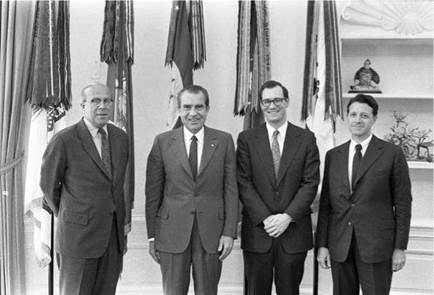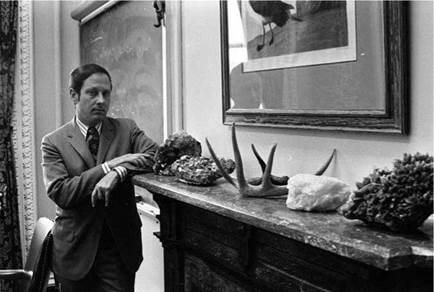On December 3, 1968, President-elect Nixon created a transition task force on space, chaired by Nobel Prize-winning physicist Charles Townes of the University of California at Berkeley. This task force was one of 17 such panels established by the president-elect; their creation followed the model that had been originated by John Kennedy in 1960.22 The members of the space transition task force in addition to Townes were Spenser Beresford, Lewis Branscomb, Francis Clauser, Harry Hess, Norman Horowitz, Samuel Lenher, Ruben Mettler, Charles O’Dell, Alan Puckett, Walter Roberts, Robert Seamans, and James van Allen. Seamans had been a senior NASA official from 1960 to 1968 and during the transition became Nixon’s choice for Secretary of the Air Force; he seems to have had a particularly strong impact on the conclusions. Of the other members, Beresford was a Washington lawyer with experience on space issues as a Congressional staffer. Lenher, Mettler, and Puckett were leaders in the aerospace industry; Branscomb, Clauser, Hess, Horowitz, O’Dell, Roberts, and van Allen were well-known scientists. All had had some significant exposure to space issues prior to their transition team service. Thus they spent little time in factfinding and never met as a group; rather, they worked by exchanging draft inputs to prepare what was intended to be a consensus report. In addition, Townes was also a member of the Space Science and Technology Panel of the President’s Science Advisory Committee (PSAC); Branscomb was chair of that panel. The PSAC panel had met in December 1968 and prepared a report “with malice aforethought” that fed into the transition team activity. Townes met with president-elect Nixon on January 8 to brief him on the task force conclusions.23
The task force’s report identified a number of issues and presented related recommendations. Among them were the following.
Is any significant change required in thrust or content of the present space program? A new look is required at the balance between the manned and unmanned segments of the NASA space program.
What should be the objectives and scope of the manned program? While this issue is complex, and the function of man in space not yet clear, a considerable majority of the task force believes there is a substantial role for man in the long term, and that a continued manned flight program, including lunar exploration, is justified at present.
What are the program items and their urgency for the immediate future?
Various items needing special consideration are
a. A manned space station. We are against any present commitment to the construction of a large space station.
b. [omitted]
c. Lunar exploration. Lunar exploration after the first Apollo landing will be exciting and valuable. But additional work needs to be initiated this year to provide for its full exploitation.
d. Planetary exploration. . . The great majority of the task force is not in favor of a commitment now to a planetary lander or orbiter.
Cost Reduction and “Low Cost” Boosters. The unit costs of boosting payloads into space can be substantially reduced, but this requires an increased number of flights, or such an increase coupled with an expensive development program. We do not recommend initiation of such a development, but study of the technical possibilities and rewards.
International Affairs. Space operations put in a new light many international questions and also lead naturally toward some areas of international cooperation. We believe these offer opportunities for initiatives and some progress towards world cooperation and stability, and the U. S. should exploit these opportunities with both care and vigor.24
With respect to NASA, the task force estimated that a $4 billion annual budget, “about % of one per cent of the GNP, does not seem excessive in view of the importance of the space developments to the nation.” This figure included $2 billion annually for human space flight; the majority of the task force members accepted that the United States would have a continuing human space flight program into the indefinite future. The task force believed that because “a considerable number of boosters and space vehicles will remain after the first lunar landing, it is possible to have an active and successful manned program for several years while at the same time steadily decreasing the level of funding for manned space flight to perhaps $1.25 billion by fiscal 1972.” While it accepted in principle the existence of a post-Apollo human space flight effort, the panel thought that “it would be undesirable to define at this time a new goal that is both very ambitious in scope and highly restrictive in schedule, for example a manned landing on Mars before 1985, even though such a goal might be achievable. Such a commitment, adopted now, might inhibit our ability to establish a proper balance between the manned space program and the scientific and application programs.”25 These findings and recommendations closely foreshadowed the approach the Nixon administration would take in its post-Apollo space decisions, including continuing human space flight, not setting another ambitious space goal, not approving space station development, and giving higher priority to international space cooperation than had been the case during the 1960s.
NASA did not receive a copy of the Townes report until sometime in March 1969, and it took another two months to generate its response. Tom Paine’s response to the report, not surprisingly given his bullish approach to NASA’s future, took umbrage at the report’s tone, while welcoming its endorsement of the need for a vigorous U. S. space program. But, Paine asked, “What do we mean by the word ‘vigorous’?” If “one associates vigor with youth, with growth, and with the promise of future accomplishments, one can only view the state of affairs in our space program with serious concern for the future.” Paine also objected to the report’s opposition to a near-term commitment to any major future space undertaking, suggesting that this posture was a continuation of the situation in which NASA had found itself in the final years of the Johnson administration. He complained that “we have been frustrated too long by a negativism that says hold back, be cautious, take no risks, do less than you are capable of doing.”26
NASA’s frustration was understandable. Given the uncertainty that accompanies the arrival of any new president, combined with the recognition that the 1961 commitment to a lunar landing by the end of the decade would soon lose its potency as the central focus around which NASA could organize its efforts, the fact that the Townes report took a “go slow” approach to the future in space meant that NASA, as it approached humanity’s first steps on a celestial body other than Earth, had little sense of what might lie ahead. It was squarely up to the new administration of President Richard Nixon to chart America’s future course in space. If the recommendations of the Townes report were to be the foundation of the Nixon space policy, that course would be a very different one than NASA had been following and hoped to continue to pursue.












